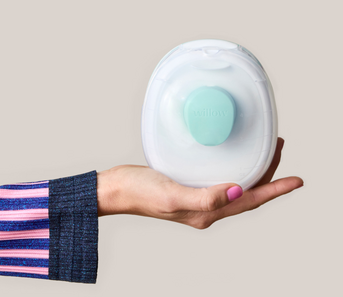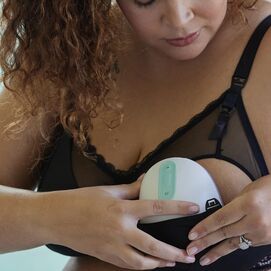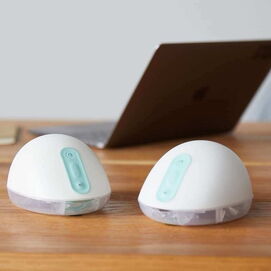As a new or soon to be mom, you cherish every moment watching your little one grow. These early years are vital for your baby's brain development and they help to shape the person they will one day grow into.
Understanding just how their brain develops and matures from inside the womb to months after birth is one of the first steps in creating a supportive and caring environment for your little one to be their very best self!
Lucky for you, we've got the 411 on infant brain development including everything from major functions to how your baby's brain develops over the course of each trimester.
A Breakdown of Your Baby's Brain Composition
You may be wondering how your baby's brain functions, and if the brain looks any different during pregnancy - actually, it looks quite similar to yours.
Essentially, the human brain is comprised of three main parts - the brain stem and cerebellum, the limbic system, and the cerebral cortex that splits into four lobes that are responsible for a range of body functions and capabilities.
This general functioning doesn't change during or after pregnancy, but researchers have found that pregnancy can shrink the brain's grey matter. This is the pinkish-grey tissue that contains cell bodies and synapses of nerve cells -but don't worry! It's actually a good thing, as it makes for more efficient brain circuits and allows for "fine tuning" social cognition abilities such as nurturing tendencies and awareness of what others are feeling.
Brain Stem and Cerebellum
The brain stem connects to the spinal cord, offering movement and a number of other bodily functions such as breathing, heart rate, blood pressure, balance, and reflexes of the body.
Dorsal to the brain stem sits the cerebellum, which plays a significant role in controlling motor coordination. Both the cerebellum and brain stem are crucial parts of the body, as they have major responsibilities in the general maintenance of life.
Limbic System
This is your survival mechanism hub - the limbic system is in charge of all things relating to behavioral or emotional responses including thirst, hunger, learning, and a number of other daily rhythms your body produces.
The limbic system can also facilitate memory storage, control emotional states, and establish functions of feeding, reproduction, and caring for our young.
Cerebral cortex
The cerebral cortex contains the four lobes: frontal, occipital, temporal, and parietal. Each is responsible for a number of functions such as:
-
Frontal: prospective memory, planning, personality, attention, consciousness, problem solving, and other decision making skills.
-
Occipital: visual processing, interpretation, and assigning meaning to what the eyes are seeing.
-
Temporal: long term memory, object recognition, and sensory processing such as pain and auditory stimuli.
-
Parietal: learning, language, spacial recognition, and handles other sensory information such as touch, taste, and temperature.
The 3 Stages of Baby Brain Development During Pregnancy
Even before birth, your baby's brain is well on it's way to becoming healthy and strong. So when exactly does the brain start to appear?
Your fetus can start forming a brain in just the first trimester, and continue to evolve and develop through birth and into the years that follow. We've briefly mapped out what happens when, so you have an idea of how your little one is beginning to grow.
Developments Made in the First Trimester
Rapid developments start to appear in just the first trimester. Following general limbs and body parts, a rudimentary brain begins to form and later splits off into 3 parts, forebrain, midbrain, and hindbrain, by the end of the trimester. Nerve connections also begin to form, beginning movement in the womb.
Developments Made in the Second Trimester
Once the cerebellum develops, more nerve developments and brain tissue continue to form, allowing your baby to move around more - this can result in kicks and stretches which you may begin to feel!
Developments Made in the Third Trimester
During the third trimester, the cerebral cortex starts to form that will later help with learning and life functions once out of the womb. They begin to grow hair, finger/toenails, and can detect light.
Your baby also begins to hear noises for the first time, and will be able to recognize your voice. Playing music or singing to your child can have great benefits, even when they're still cozy in the womb!
The Postpartum Baby Brain
Once your baby is born, they have all the essential motor functions they'll need in the first few months of life - they can move, hear, see a little, and make noise.
In fact, our brains are almost fully grown by the age of 5, reaching 80% of adult size by age 3, and 90% of brain growth happening before we even reach Kindergarten! But the learning doesn't stop there - the brain is far from being completed, and will continue to grow and develop as they navigate infancy, childhood, and even young adulthood.
It's important to recognize that each baby hits growth milestones on their own time. The most important thing you can do for your child is making sure they have a safe and supportive environment to grow into themselves in!
Engaging your baby in brain-boosting activities such as music, language, exercise, social behavior, and academics is extremely beneficial in the early stages of life, and proves to boost both moods, attitudes, and performance levels. Plus, spending time with your baby, teach them new things, read, listen to music, play, cuddle, create bonding experiences!
Ways to Promote Healthy Brain Development
Motherhood is an exciting new chapter for you and your little one! Nothing can describe the feeling of love and joy, watching them grow and develop into their own self.
As they grow beyond birth, breastfeeding can help create an even stronger bond between you and your baby and contribute to a healthy development. Here at One Willow, we're here to help you support your little ones, so you can take the pressure off and focus on what's most important, together.













